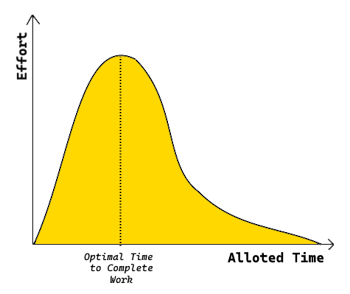Parkinson's Law
Work expands to fill the time available.
"Work expands so as to fill the time available for its completion." 1

Parkinson's Law was first articulated by British naval historian and author C. Northcote Parkinson in a 1955 essay in The Economist.2 He observed, somewhat satirically, that "work expands so as to fill the time available for its completion." While his original context critiqued bureaucratic inefficiencies, the principle has broad relevance in Agile environments. Agile teams strive to maintain cadence, adaptability, and focus on delivering value, but if not careful, they can fall prey to the very dynamic Parkinson described. Whether in padded estimates, idle pacing, or overloaded ceremonies, the law reveals how time itself can unconsciously dictate behavior. Agile methods like Scrum and Kanban introduce timeboxes and flow limits to counteract this tendency, but teams must remain intentional to avoid the trap of performing to the clock instead of to customer outcomes.
Impact on Agile Teams
When Parkinson's Law influences Agile teams, delivery patterns often degrade subtly. Teams become more concerned with filling their allotted time than with optimizing for efficiency, leading to behaviors that undermine flow, quality, and continuous improvement.
- Timeboxing and Overcommitment:
- Teams use the full Sprint period regardless of how simple the work is.
- Effort and attention get spread thin instead of concentrated on completing work early and well.
- Misleading Velocity Trends:
- Consistent velocity may mask bloated estimates or inefficient pacing.
- Teams develop a habit of matching work to time instead of matching effort to complexity.
- Postponed Completion Activities:
- Testing, integration, documentation, and reviews get delayed until the final days of the Sprint.
- This creates last-minute pressure, introduces defects, and shortens feedback loops.
- Estimate Padding and False Precision:
- Teams add buffer time to protect against the unknown, which encourages slower pacing.
- Leaders may misinterpret large estimates as confidence, not caution.
Scenario
An Agile team working in two-week Sprints consistently delivers a similar number of stories. At first glance, things appear stable. However, each Sprint follows a familiar rhythm:
- Early days are quiet, as the team "settles in".
- Mid-Sprint reviews show little progress but raise no concern.
- The final two days trigger frantic efforts to test, polish, and complete stories.
- Some work gets rushed across the finish line, while others are deferred.
Retrospectives raise the issue, but the team rationalizes it as "just the way it works". Velocity remains steady, yet predictability and quality fluctuate. The team has become time-bound instead of value-driven.
Ways to Mitigate Parkinson's Law in Agile Teams:
Agile teams can limit the influence of Parkinson's Law by aligning practices around value flow rather than time occupation.
- Focus on Flow Efficiency:
- Visualize flow with Cumulative Flow Diagrams or Control Charts.
- Track lead time and cycle time more closely than Sprint length or velocity.
- Limit Work In Progress (WIP):
- Encourage teams to finish before starting new work.
- Swarm on fewer stories to promote completion and reduce multitasking.
- Reinforce the Definition of Done:
- Emphasize that stories are not "done" until they're fully tested and reviewed.
- Break large stories into smaller, more verifiable units.
- Conduct Mid-Sprint Reviews:
- Establish a midway check-in to track progress and balance the workload.
- Reallocate effort early if stories are slipping.
- Avoid Estimate Padding:
- Use relative sizing with historical calibration rather than fear-based buffers.
- Invite transparency and psychological safety during estimation sessions.
- Timebox with Purpose:
- Use time constraints to generate focus, not to justify delays.
- Keep ceremonies crisp and outcome-oriented, not filler-driven.
Conclusion:
Parkinson's Law serves as a cautionary lens for Agile practitioners. It reveals how time can subtly become the container for effort, even in environments that champion adaptability and speed. Teams that structure their work around capacity instead of outcomes often confuse motion with progress. Counteracting this law requires a shift in mindset—from occupying time to accelerating value. Agile ceremonies, metrics, and team dynamics must be designed to highlight flow and outcomes, not just activity.
Key Takeaways
- Parkinson's Law exposes a common pitfall where Agile teams unconsciously expand work to match timeboxes.
- This leads to bloated estimates, backloaded delivery, and artificial stability in metrics.
- Agile practices should emphasize flow efficiency, swarming, and outcome-driven iteration.
- Visual management and purposeful pacing are effective tools to reduce time-based drag.
Summary
Though it originated in satire, Parkinson's Law reflects a deeply human tendency that can quietly erode Agile performance. Teams that operate within timeboxes are not immune to its effects. Instead of assuming that iterative cycles prevent waste, Agile teams must remain vigilant. They should measure progress by customer value delivered and lead time shortened, not simply by how well they filled the calendar. With flow-focused tools, honest estimation, and disciplined work habits, teams can neutralize Parkinson's pull and keep their momentum aimed at real outcomes.